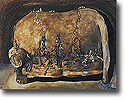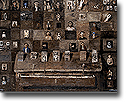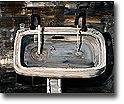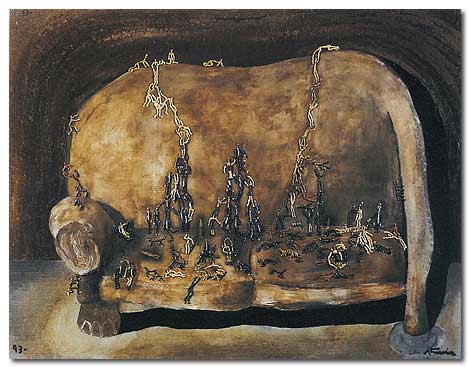Boca Raton Museum of Art,
Sep 08, 2004 - Nov 07, 2004
Boca Raton, Fl, USA
Ignacio Iturria: Everything Has A Face
by Wayne Baerwaldt
Iturria’s process of structuring appearance pays homage to a long-standing neo-magical tradition in Latin American painting. His creative output as a transgressor of painting’s traditional support surface insists the work wants to be more than painting. Iturria’s art reflects a recurrent impulse to sculpt, certainly in the form and scale of his intimate as well as large scale paintings (see "Stanno tutti bene II") but particularily in the awkward, often totemic furniture pieces when he most successfully melds painting and sculpture. Using cardboard and paper mache as both recognizable form and makeshift support surface, Iturria paints over abstracted "household furniture" --- cupboards, writing stanzas, bookcases and overstuffed furniture. As support structures for painting, the furnishings have an elegance that commands attention but ultimately Iturria’s aim is to make the painting self-sustaining, obliterating the support surface in the process.
The painted surfaces contain and embolden the quirky, handcrafted qualities of the forms in their gross abundance. His cupboards have a stately bearing (ranging in height to six feet) but on closer inspection their temporary, fragile nature is revealed in warped surfaces of thin layers of paper, cardboard and paint. They wallow and roll in elements that are never quiescent. His largely barren cupboards and more recent eviscerated pop-up picture coffee tables are sentries that mimic the stark abstract high-rises or human containers depicted in his paintings. Some work may recall the cement encased wooden furniture sculpture of the Columbian artist Doris Salcedo. However, Iturria’s forms are more whimsical than the haunted sentinels of Salcedo. If nothing else the vacuity of their sculptures respectively mirror the artists’ collective memory of repressive political systems--- right-wing military juntas common in the histories of South American countries. Iturria’s metaphorical language nevertheless remains historically and regionally disparate, linked to traces of Salvador Dali’s Cadaques-inspired surrealism (from the countryside that featured wildly evocative winds --- which Iturria experienced during a seven year residence in Basque Spain) or the grotesque forms of the American painter George Condo. Each is evidence of traditions in academic Euro-Americas abstract art whose true roots are firmly entrenched elsewhere, in authentic forms of Pre-Columbian art and Peruvian weavings, virtually on the doorstep of Iturria’s birthplace.
Iturria’s totemic furniture sculptures and free-standing mixed media assemblages (i.e., Homenaje a Morandi) move back and forth in time as easily as he abandons physical laws and laws of perception. The sculptural furnishings may appear as apt metaphors for sprawling high-rise residential developments in Miami, New York, Toronto and elsewhere in the Americas. Iturria’s sculptures are geometric reductions of the urban built environment, playfully arranged as floor models at a contemporary furniture exposition. However, Iturria’s stylistic and esthetic roots owe a primary and more significant debt to the rise of the hybrid abstract art forms of the 20th century, made familiar to the artist from museum holdings in Uruguay and neighboring Argentina.
|









